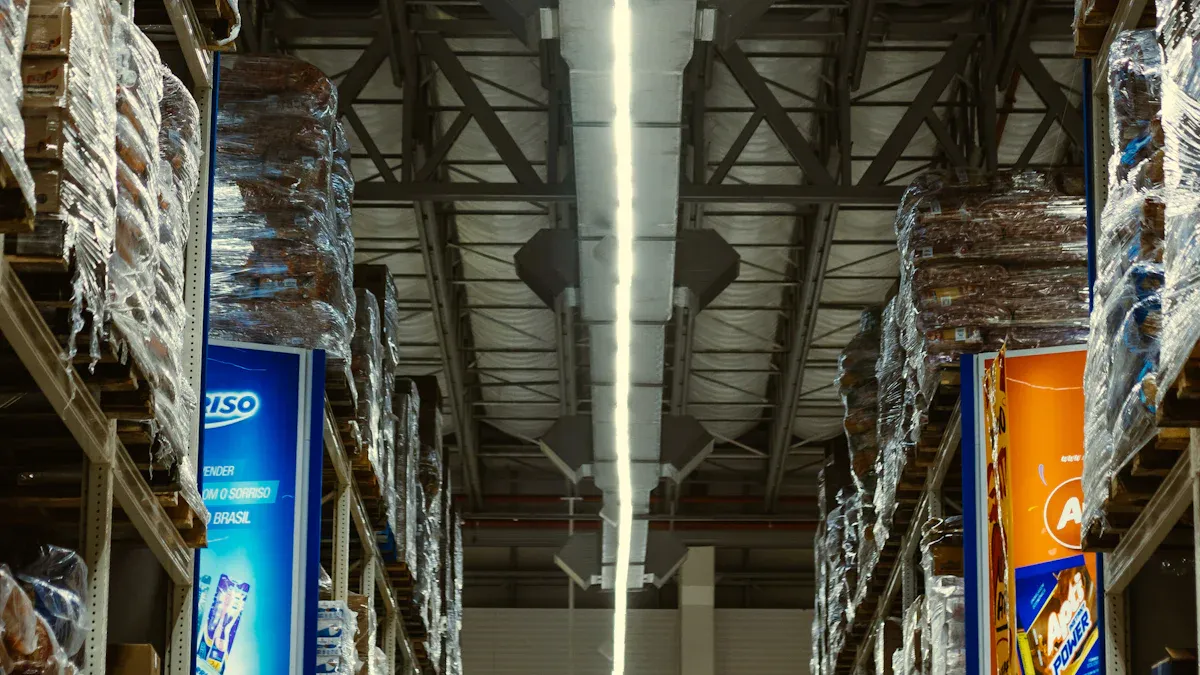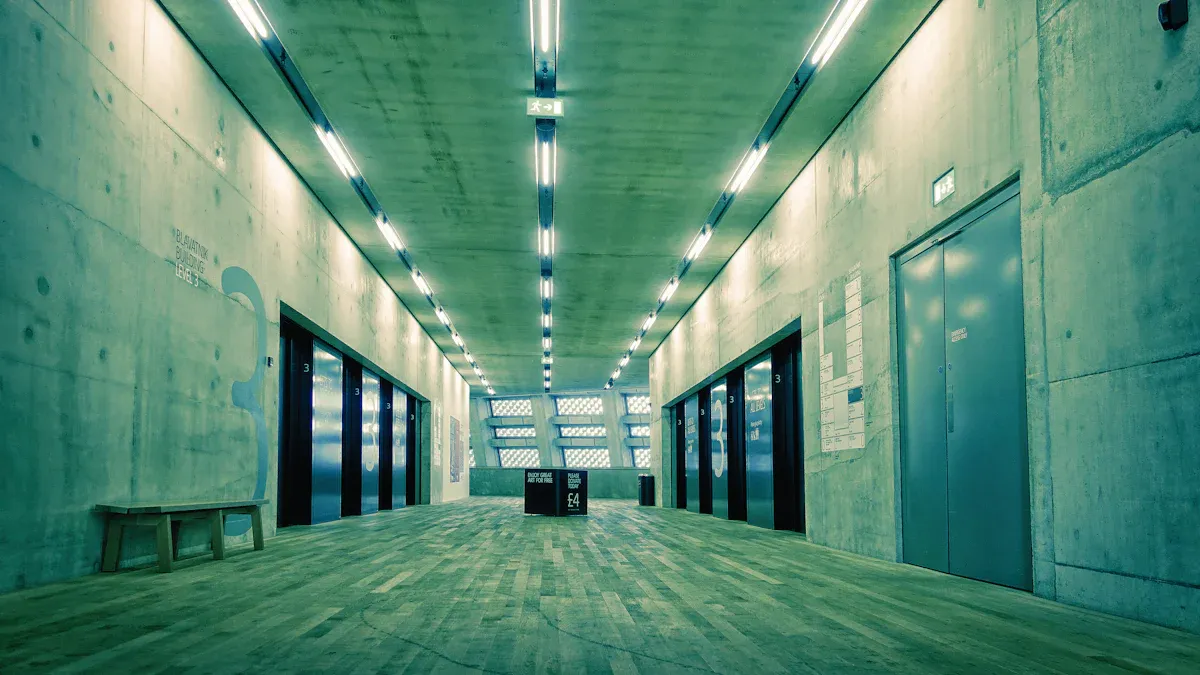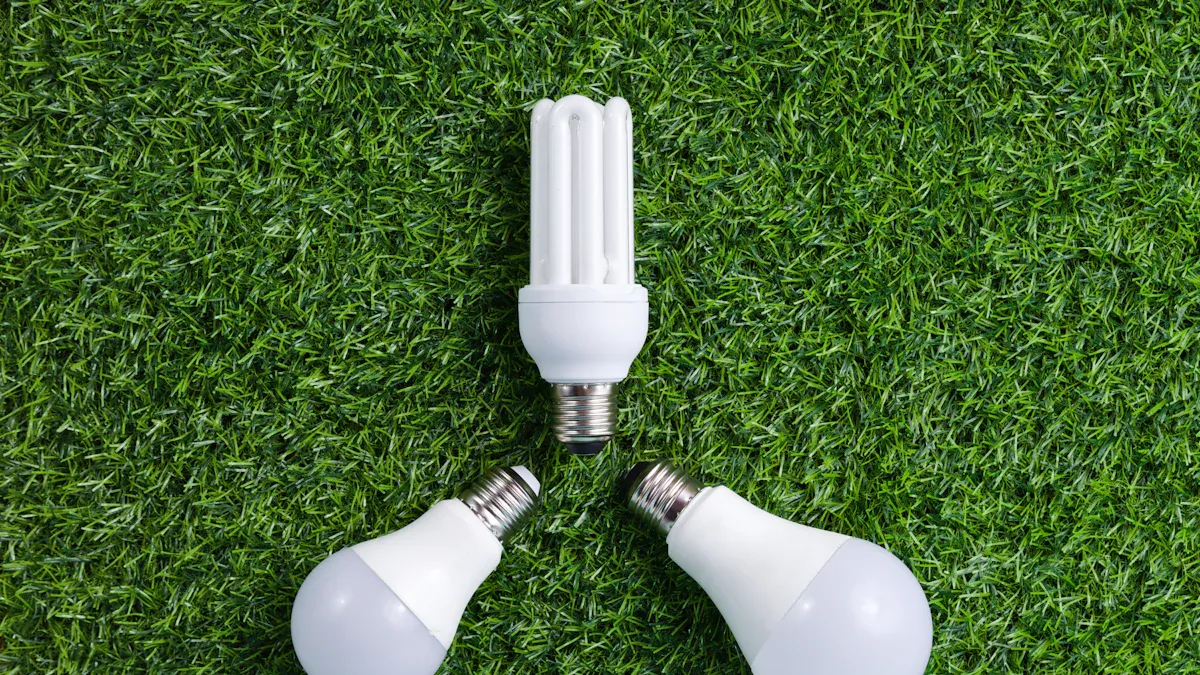High Bay Lighting LED Conversion

Switching to LED lights for high bay lighting areas offers numerous advantages. LED high bay lights consume significantly less energy, allowing for savings of up to 80% on electricity costs. They generate an impressive 130-150 lumens per watt, providing exceptional brightness. Unlike traditional lighting, LEDs convert 95% of energy into light, minimizing heat waste. This efficiency translates into substantial savings for businesses. For instance, replacing 10 conventional bulbs with LED lights that are used for five hours daily can lead to an annual savings of approximately $52. Additionally, LEDs deliver consistent brightness and superior light quality, making them ideal for expansive spaces such as warehouses or gyms.
🌟 Tip: Consider using solar light options or LEDs with motion sensors to enhance energy savings by activating lights only when necessary.
Discover more about how LED lighting outperforms older systems in our About Us section.
Key Takeaways
Using LED high bay lights can lower electricity bills by 80%.
LEDs work for over 50,000 hours, so they need fewer changes.
Picking LED lights with high lumens-per-watt gives better brightness.
Installing them correctly and checking system fit is very important.
Choose trusted brands with UL or DLC labels for good quality.
Benefits of LED High Bay Lighting

Energy Efficiency and Reduced Power Consumption
Using LED high bay lighting helps save a lot of energy. Places that switch to LEDs often cut lighting costs by 65-75%. For example, one factory lowered its monthly energy bill from $6,840 to $1,710. That’s a 75% drop! This is because LEDs turn most energy into light, not heat, unlike older lights. LEDs also last over 50,000 hours, so they need fewer replacements. This saves even more energy and resources.
💡 Did You Know? By 2030, 87% of all lights are expected to be LEDs, making them the top choice for saving energy.
Cost Savings Over Time
Switching to LED high bay lighting saves money in the long run. Businesses pay less for electricity and maintenance. LEDs use much less energy than older lights, which means big savings over time. They also last longer, so you don’t need to replace them often. This reduces costs for labor and materials.
Here’s how costs compare before and after switching to LEDs:
Metric | Before LED Conversion | After LED Conversion | Improvement |
|---|---|---|---|
Annual Fixture Replacements | 85 | 7 | 92% reduction |
Annual Maintenance Cost | $15,300 | $4,600 | 70% reduction |
Production Interruptions | 24 hours/year | 3 hours/year | 87.5% reduction |
These savings make LED high bay lighting a smart choice for cutting business costs.
Enhanced Lighting Quality and Longevity
LED high bay lights give better light than older options. They stay bright and show colors clearly, making large spaces like gyms or warehouses easier to see in. Better lighting can improve safety and help people work better. Unlike older lights, LEDs don’t dim over time. They last up to 25 times longer than regular bulbs, so you won’t need to replace them often. This makes them reliable for years.
🌟 Pro Tip: Choose LEDs with high lumens-per-watt for the best brightness and energy savings.
The Conversion Process

Checking Your Current Lighting System
Before switching to LED high bay lighting, check your current setup. This helps you find what needs improvement. Look at the layout of your space. Measure ceiling height and the distance between lights. These details help you pick the right LED fixtures.
Next, check how well your current lights work. Are they bright enough? Do you see dark spots or uneven lighting? Write down these issues to plan your upgrade. Also, compare the energy use of your current lights with LEDs. Look at wattage and lifespan to see how much you can save.
Experts suggest testing LED systems for performance and durability. For example, the Lighting Research Center advises checking how long LEDs last. Below is a table with helpful resources for evaluating lighting systems:
Title | Source |
|---|---|
Photosensor long-term performance study | IES 2021 Virtual Annual Conference, August 9-13, 2021 |
ASSIST recommendations for testing LED lighting systems | Lighting Research Center, Vol. 14, Iss. 1, Troy, N.Y. |
LED lighting product life and failure | Lightfair International 2018, May 10, 2018, Chicago, Illinois |
Predicting LED system life | Proceedings of the IES 2017 Annual Conference, August 10-12, Portland, Oregon |
Assessment of Solid-State Lighting, Phase 2 | The National Academies Press, Washington DC |
🛠️ Tip: Use tools like light meters to check brightness and ensure your new LEDs meet your needs.
Picking the Best LED Fixtures
Choosing the right LED fixtures is very important. Look for luminous efficacy, which shows how much light is made per watt. Higher luminous efficacy means brighter spaces and lower energy costs. For instance, the Metalux OHB gives 207 lumens per watt, while the Orion Energy Systems HARRIS offers 189.9 lumens per watt.
Also, check for certifications that prove quality and safety. Certifications like UL and CE ensure the fixtures meet industry standards. Below is a table of certifications to look for:
Certification | Link |
|---|---|
UL – LED High Bay – Authorization to Mark (Non-Hazardous – UL1598/A) | Link |
UL – Vigilant Ultra-Efficient LED High Bay EPD Certification | Link |
CE – High Bay & Low Bay Declaration of Conformity | Link |
🌟 Pro Tip: Pick fixtures with warranties of 10 years or more for long-lasting performance.
Installing or Upgrading Your Lights
After choosing your LED fixtures, it’s time to install them. You can either replace old fixtures or retrofit them. Retrofitting means adding LED parts to your current lights, which can save money.
For installation, make sure the wiring and mounting are correct. LED high bay lights need specific voltage levels, so check your electrical system. If retrofitting, follow the manufacturer’s instructions carefully.
It’s a good idea to hire an electrician for tricky installations. This ensures safety and follows local rules. After installation, test the lights to see if they meet your brightness and energy-saving goals.
⚡ Note: Add motion sensors or dimmers to save even more energy by adjusting light levels based on activity.
Cost and ROI Analysis
Upfront Costs vs. Long-Term Savings
Switching to LED high bay lights costs money at first. But over time, you save more on energy, repairs, and replacements. For example, savings from labor and bulbs grow each year. Here's a simple chart showing possible savings:
Year | Upfront Costs | Labor Savings | Extra Lamp Savings | Total Savings |
|---|---|---|---|---|
1 | $X | $4,983 | $0 | $4,983 |
8 | $X | $125,790 | $42,000 | $167,790 |
You can also lower upfront costs with financial help. These include:
Local grants or tax rebates
State and federal programs
Tools like the DSIRE database
With these savings and programs, starting with LED lights becomes easier to afford.
Calculating ROI for LED Conversion
Figuring out the return on investment (ROI) shows how fast savings cover costs. Follow these steps to calculate ROI:
Find details like wattage of old and new lights, hours used daily, and electricity rates.
Subtract the new LED wattage from the old wattage to find energy saved per light.
Multiply daily hours by days in a year to get yearly usage.
Turn energy savings into kilowatt-hours (kWh) by multiplying savings per light by yearly usage.
Multiply kWh savings by your electricity rate to find yearly money saved.
For example, if old lights use 400 watts and new LEDs use 150 watts, you save 250 watts per light. Multiply this by total hours and your electricity rate to see yearly savings.
By using these steps, you can see how fast your investment pays off and how much you’ll save later.
Common Challenges and Solutions
Fixing Compatibility Problems
Switching to LED high bay lighting can cause some problems. These happen when old systems don’t match LED technology. Issues like flickering or dimming may occur. Sometimes, lights might turn off without warning due to mismatched parts.
Here’s a table of common compatibility problems:
Compatibility Problem | Description |
|---|---|
Old System Issues | Older dimmers or ballasts may not work well with LEDs. |
Uneven Dimming | LEDs may not dim smoothly with current systems. |
Lights Turning Off | Some lights may shut off due to mismatched parts. |
Flickering at Low Levels | Flickering can happen when dimmed too low. |
Fixture Problems | Old fixtures might need changes or new drivers for LEDs. |
Wiring Changes | Wiring and ballast checks are needed when switching from HID lights. |
To fix these problems, check your current fixtures and wiring. Make sure dimmers and ballasts work with LEDs. If not, upgrade them. Old fixtures might need new drivers or changes to work properly.
💡 Tip: Ask an electrician to check your system and suggest upgrades for smooth operation.
Installing LEDs the Right Way
Good installation is key to getting the most from LED high bay lighting. Bad installation can cause safety risks and poor performance. Following proper steps ensures your lights work well and safely.
Here’s how to install LEDs correctly:
Hire a trained electrician to follow safety rules.
Secure all lights tightly to avoid accidents.
Use safe tools and gear when working high up.
Provide temporary lights for better visibility during work.
Make a safety plan and check for risks before starting.
Teach workers safety tips to lower risks.
By following these steps, you can avoid problems and make sure your LED high bay lights work great.
⚠️ Note: Always focus on safety during installation. Careful planning and training help avoid accidents and ensure success.
Tips for Choosing the Right LED High Bay Lights
Key Features to Look For
When picking LED high bay lights, focus on features that improve performance. Start by checking energy efficiency, shown in lumens per watt (lm/W). Higher numbers mean more savings and lower power bills. For example, lights with 130-150 lm/W work great in big spaces.
Think about color temperature, measured in Kelvin (K). This changes how the space feels and works. Warm tones (3000K) are cozy, while cool tones (5000K) fit warehouses or gyms. Light distribution is also important. It shows how evenly light spreads, avoiding dark spots.
Customer reviews can help you learn about product quality. They share real-life experiences and common problems, helping you choose wisely.
Feature | Description | Why It Matters |
|---|---|---|
Energy Efficiency | Lumens per watt (lm/W). Higher numbers mean better efficiency. | Saves energy and lowers electricity costs. |
Color Temperature | Measured in Kelvin (K). Affects how the space looks and feels. | Matches lighting to the purpose of the area. |
Light Distribution | Shows how light spreads across the space. | Ensures even lighting without dark areas. |
Customer Feedback | Reviews from users about quality and performance. | Helps find reliable products and avoid issues. |
Also, check for designs that fit your needs. Compact lights save space, and easy-to-install fixtures save time. Features like glare reduction make spaces more comfortable and clear.
💡 Tip: Pick lights that last over 50,000 hours to save on replacements and repairs.
Reputable Brands and Certifications
Buying LED high bay lights from trusted brands ensures good quality. Look for certifications like UL and DLC. UL means the product passed safety tests. DLC shows the light is energy-efficient and reliable, which can qualify for rebates.
For instance, a 100W LED High Bay Light with UL and DLC certifications is both safe and efficient. These labels prove the product meets strict standards.
UL certification checks for safety issues.
DLC certification confirms energy savings and dependability.
Brands like Metalux, Orion Energy Systems, and Lithonia Lighting are reliable. Their lights are strong, efficient, and last a long time.
🌟 Pro Tip: Always check certifications to make sure your lights meet safety and energy standards.
Changing to LED high bay lights has many advantages. You spend less on electricity and repairs while getting brighter, steady lighting. LEDs work longer and stay reliable, making them great for big areas. Over time, these savings grow, helping your budget.
Start improving your lighting now. Look into LED choices that suit your space or ask an expert for help. Your space deserves top-quality lighting.
FAQ
How long do LED high bay lights last?
LED high bay lights last over 50,000 hours. If used 12 hours daily, they can work for more than 11 years. Their long life means fewer replacements, saving both time and money.
Can LED high bay lights handle cold weather?
Yes, LEDs work great in cold places. Unlike older lights, they stay efficient even in freezing temperatures. This makes them perfect for cold storage, warehouses, and outdoor areas.
Are LED high bay lights adjustable?
Many LED high bay lights let you dim the brightness. You can change the light level to fit your needs. This saves energy and makes spaces more comfortable. Check the product details to ensure it supports dimming.
Do LED high bay lights need special care?
LEDs need very little care compared to older lights. Clean the fixtures and lenses regularly to keep them working well. Their strong design and long life mean fewer repairs and lower upkeep costs.
How do I pick the right wattage for my area?
Choose wattage based on ceiling height and room size. Taller ceilings need higher wattage for enough light. Use a lighting calculator or ask an expert to find the best choice.
💡 Tip: Look at lumens, not just wattage, to measure brightness correctly.
See Also
A Detailed Process for Installing High Bay LED Fixtures
Comparing UFO, Linear, and Round Designs for LED High Bays
Exploring Applications and Benefits of LED Industrial High Bays
Understanding Applications and Benefits of LED High Bay Lights
Complete Guide to Switching from Fluorescent to LED Lighting

